This article was co-authored by wikiHow staff writer, Danielle Blinka, MA, MPA. Danielle Blinka is a Writer, Editor, Podcaster, Improv Performer, and Artist currently living in Houston, TX. She also has experience teaching English and writing to others. Danielle holds a Bachelor of Arts in English, Bachelor of Arts in Political Science, Master of Arts in English with a concentration in writing, and Master of Public Administration from Lamar University.
There are 8 references cited in this article, which can be found at the bottom of the page.
This article has been viewed 8,455 times.
Learn more...
You love horses, so why not dedicate your life to helping them? Equine physiotherapists give horses physical therapy to treat injuries, relieve pain, or improve performance. Not only will you spend your days working with horses, you’ll get to meet fellow animal lovers like yourself. There are several paths to becoming an equine physiotherapist, and programs depend on where you live.
Steps
Education
-
1Research the educational options in your area. Unlike with other careers, training for equine physiotherapists varies greatly depending on where you live. Some areas don’t offer traditional university programs. However, you can find full degree programs at some schools. Check the programs offered in your area so you can pick the right option for you.[1]
- Regions with a strong agricultural sector will typically offer more training options. If your region has a lot of farms or pastures, you’ll probably have better luck finding a program.
- There is no license for veterinary physiotherapists. However, you may apply for a license to work as a physical therapist if you complete a bachelor's degree in human physiology.[2]
-
2Get an undergrad degree in veterinary physiotherapy if you find a program. While this is the easiest option for your education, these programs are super rare. Look for a program close to you or in an area you’re prepared to move to. Once you complete your studies, you’ll be able to enter the job market immediately.[3]
- If you live in the U.K., you can find a bachelor's degree program at Writtle University College, Harper Adams University, Moreton Morrell College, Berkshire College of Agriculture, or The College of Animal Physiotherapy. You may be able to enroll in a program online.
- In the U.S., only the University of Tennessee has a program for equine rehabilitation.[4]
- Don’t worry if you can’t find an undergraduate degree program dedicated to veterinary physiotherapy. Most people get their training after they get an undergraduate degree.
Advertisement -
3Earn an undergrad degree in human physiotherapy for the best start. Animal bodies aren’t that different from human bodies, so training in human physiotherapy is a great path for an equine physiotherapist.[5] Enroll in a 4-year bachelor of sciences program for human physical therapists to get the best base level training for your career helping horses. You’ll learn about anatomy and physiology, as well as how to care for patients.[6]
- Tell your advisor you plan to work with horses so they can help you choose the best classes.
- This degree will save you time in your post-graduate studies.
-
4Complete a science degree if you can’t get into a physiotherapy program. Don’t worry if your school doesn’t offer a human physiology program. Instead, get a bachelor of science degree in 1 of the sciences. Ask your advisor to help you choose classes that support your career goals of working with horses.[7]
- Great options include biology, animal behavior, biochemistry, or chemistry.
-
5Attain a master’s degree in Veterinary Physiology. Your education is nearly complete! Once you earn your bachelor’s degree, apply for a master’s program. Work closely with your instructors to learn the skills you’ll need to care for horses.[8]
- Some schools refer to this degree path as Animal Physiology. Additionally, depending on where you live, it may be called an Advanced Certificate in Veterinary Physiotherapy.[9]
-
6Complete continuing professional education (CPD) to expand your skills. Like the field of medicine, veterinary physiology is an ever-evolving field, so you’ll never truly be finished with your education. Take additional courses related to animal healthcare to further your career and best serve your clients. Look for classes online, at local college campuses, and at professional conferences.[10]
- For example, you might take massage or hydrotherapy classes to learn new treatment options.
Training and Skills
-
1Volunteer to work with horses to gain experience. Physiotherapy programs and potential clients all want to see that you have experience with horses. Call around to local vets, farms, and stables to offer free labor. Clean the stables, feed the horses, groom the horses, and help manage the facilities. This helps prepare you for a job in equine physiotherapy.[11]
- For example, you might spend a few hours every weekend volunteering at a ranch.
- Document your volunteer hours so you have evidence of your hard work. Provide this to your school or clients if requested.
-
2Request an internship or apprenticeship with a local vet. If you're in school, ask your program advisor if there are any internships or apprenticeships available. Alternatively, contact the local large animal vets in your area to see if they'll take you on as an intern or apprentice. If they don't have any positions currently available, offer to work unpaid for a certain number of hours each week. This way, you'll gain valuable experience that can help you get your career started.[12]
- For example, you might work 1 day a week as an unpaid intern.
- You may find a paid internship or apprenticeship that hires you full-time.
-
3Apply for an entry-level job at a veterinary clinic. You don't have to wait until you finish school to help animals. Look for a job working the front desk or as a veterinary technician at a local vet clinic. Prioritize large animal vets, since you want to work with horses, but don't shy away from other clinics if they're able to hire you. This will get your foot in the door for your eventual career as an equine physiotherapist.[13]
- If you have no training, look for a job working at the front desk or doing administrative tasks.
- Consider training as a veterinary technician so you can start working with animals. Most vet tech programs take 2 years, but you may be able to complete your training in 18 months. Keep in mind that completing a vet tech program may also increase your chances of getting admitted into a veterinary physiotherapy program.
-
4Shadow an animal physiologist so you can get hands-on experience. Connect with a mentor who can help you get all the training you need to rehabilitate horses. Find an animal physiotherapist who operates their business close enough for you to travel to them. Then, accompany them on their house calls to assess and treat horses. Ask your mentor to show you how to do the following:[14]
- Assess the horses.
- Exercise the horses.
- Manipulate and mobilize joints and soft tissue.
- Prescribe an exercise or rehabilitation program.
- Perform an ultrasound
- Do laser therapy.
- Explain the treatment plan to owners.
-
5Build your communication skills so you can talk to clients. While horses are your focus, you’ll also need to work with their human owners. You’ll likely have to handle worried horse owners and deliver difficult news. Work on your communication skills by taking classes and attending workshops. You might also film yourself talking so you can evaluate yourself or do role-playing so you can practice talking to clients.[15]
- Public speaking may also help you improve your communication skills because it’ll help you get used to presenting your ideas. Join a group like Toastmasters so you can do practice speeches.
-
6Learn ways to stay calm under stress. Being an equine physiotherapist can be super stressful at times, so develop good coping skills. When you’re caring for an injured horse or talking to a stressed horse owner, it’s important that your emotions not get the best of you.[16] Here are some things you might try:[17]
- Learn breathing exercises.
- Take a walk before you see clients or right afterwards.
- Carry an aromatherapy roller with you.
- Engage your senses by focusing on smells, finding the color blue in your surroundings, or carrying a stone in your pocket that you can rub when you’re stressed.
Jobs
-
1Check the regulations in your area because they vary. Since equine physiotherapy is a developing field, every region has its own rules and requirements. Research the policies in your area before you begin seeing clients to make sure you're doing it legally. It's always a good idea to protect yourself.[18]
- You may learn this information in your veterinary physiology program.
- While there's no special license for veterinary physiotherapists at this time, you may need to get a license as a human physical therapist if your degree path included a bachelor's degree in human physiotherapy.
- In some areas, you can only treat horses who are referred to you by a vet.
-
2Get a driver’s license and vehicle so you can make house calls. As an equine physiotherapist, you’ll make a lot of house calls, so keep your driver’s license up-to-date. Additionally, purchase your own vehicle or make arrangements so you have reliable transportation. This way you can drive out to where the horses in your care live.[19]
- Even if you get a job at a vet’s office, you’ll still need to be able to drive out to the stable or pasture where the horse lives.
-
3Open your own business if you’re following the typical career path. You won’t find many job listings for an equine physiotherapist, but try not to worry. Like most equine physiotherapists, offer your services freelance to horse owners in your area. Call local large animal vets, stables, and farms to tell them about your services.[20] Additionally, promote yourself with a website, social media accounts, and business cards.
- Take a business or accounting class to help you build your business. You may even be able to take this class as an elective as part of your degree program.[21]
-
4Develop a relationship with local veterinarian’s to find clients. The easiest way for you to get clients is through a local vet. Call or visit local vet clinics to introduce yourself, explain your credentials, and tell the vet how they can contact you. Ask the vet to refer their clients with horses to you for treatment after an injury or illness or when the owner wants to improve the horse’s physical performance.[22]
- You might say, “Hi, I’m Callie. I just finished my master’s degree in Veterinary Physiology and am looking for clients. I’ve been working with horses for over 15 years since I got my first horse. I’m hoping we can have a working relationship. Here’s my card.”
- In some areas, you may not be able to take clients unless a vet referred them to you. Check the laws and ordinances in your area to find out if this applies to you.
-
5Apply for jobs at vet clinics if you’d rather work for an organization. Clinic jobs for equine physiotherapists are pretty rare, but don’t let that stop you from looking for opportunities. Call local clinics, visit their websites, and check job websites for open positions.[23] When you find one, send in your resume and a cover letter, as well as any other materials requested. Follow up with the clinic a week after you send in your application to make sure they received it and to ask how long the application process will be.[24]
- Clinics that offer rehabilitation services are most likely to have job openings for physiotherapists. However, they may expect you to work with all animals, not just horses.
-
6Join a professional organization for animal physiotherapists to boost your credentials. A professional organization will help you network with fellow equine physiotherapists and may improve your chances at finding clients or employment. Complete an application or registration to join 1 or more professional organizations. Then, pay your membership dues. Here are some well-recognized professional organizations you might join:[25]
- International Association of Animal Therapists (IAAT)
- Register of Animal Musculoskeletal Practitioners (RAMP)
- The National Association of Veterinary Physiotherapists (NAVP)
- The Association of Chartered Physiotherapists in Animal Therapy (ACPAT)
- The Institute of Registered Veterinary and Animal Physiotherapists (IRVAP)
References
- ↑ https://www.caw.ac.uk/careers/veterinary-physiotherapist/
- ↑ https://covalentcareers.com/resources/animal-rehabilitation-therapist/
- ↑ https://nationalcareers.service.gov.uk/job-profiles/veterinary-physiotherapist
- ↑ https://vetmed.tennessee.edu/vmc/EquineHospital/Documents/EPR/201007-EquineBrochure.pdf
- ↑ https://www.prospects.ac.uk/job-profiles/animal-physiotherapist
- ↑ https://www.bu.edu/sargent/academics/departments-programs/health-sciences/bs-in-human-physiology/
- ↑ https://nationalcareers.service.gov.uk/job-profiles/veterinary-physiotherapist
- ↑ https://nationalcareers.service.gov.uk/job-profiles/veterinary-physiotherapist
- ↑ https://www.caw.ac.uk/careers/veterinary-physiotherapist/
- ↑ https://www.prospects.ac.uk/job-profiles/animal-physiotherapist
- ↑ https://www.prospects.ac.uk/job-profiles/animal-physiotherapist
- ↑ https://covalentcareers.com/resources/animal-rehabilitation-therapist/
- ↑ https://vetmed.tennessee.edu/vmc/EquineHospital/Documents/EPR/201007-EquineBrochure.pdf
- ↑ https://www.prospects.ac.uk/job-profiles/animal-physiotherapist
- ↑ https://www.prospects.ac.uk/job-profiles/animal-physiotherapist
- ↑ https://nationalcareers.service.gov.uk/job-profiles/veterinary-physiotherapist
- ↑ https://www.helpguide.org/articles/stress/stress-symptoms-signs-and-causes.htm
- ↑ https://www.caw.ac.uk/careers/veterinary-physiotherapist/
- ↑ https://www.caw.ac.uk/careers/veterinary-physiotherapist/
- ↑ https://www.caw.ac.uk/careers/veterinary-physiotherapist/
- ↑ https://www.prospects.ac.uk/job-profiles/animal-physiotherapist
- ↑ https://www.prospects.ac.uk/job-profiles/animal-physiotherapist
- ↑ https://www.prospects.ac.uk/job-profiles/animal-physiotherapist
- ↑ https://money.usnews.com/money/blogs/outside-voices-careers/articles/how-to-follow-up-on-a-job-application
- ↑ https://www.prospects.ac.uk/job-profiles/animal-physiotherapist
- ↑ https://www.prospects.ac.uk/job-profiles/animal-physiotherapist
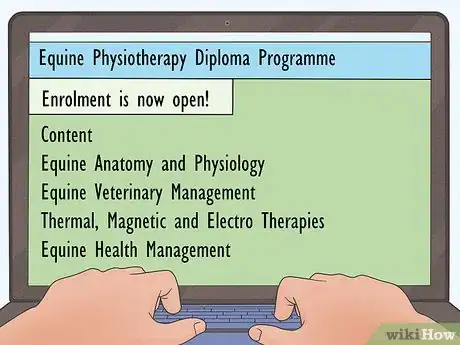
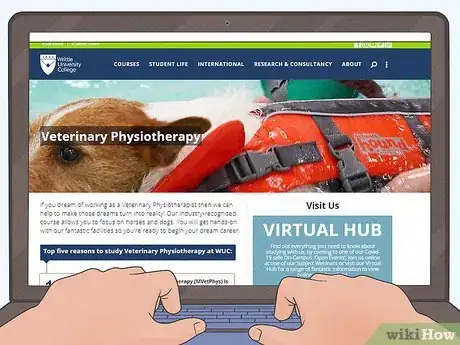



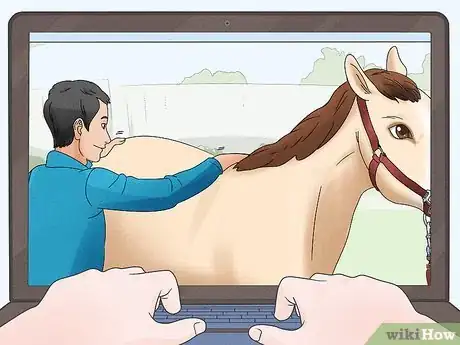
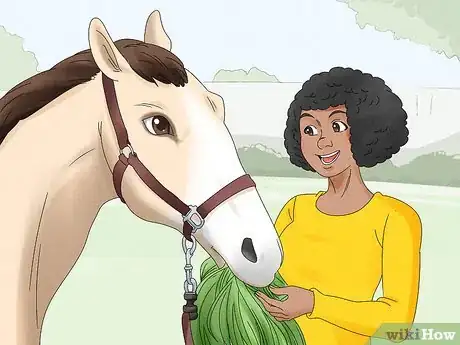










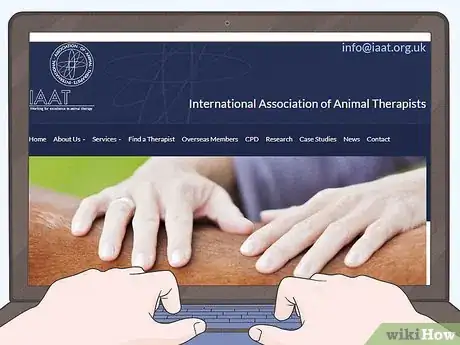



-in-Horses-Step-4-Version-2.webp)

















































